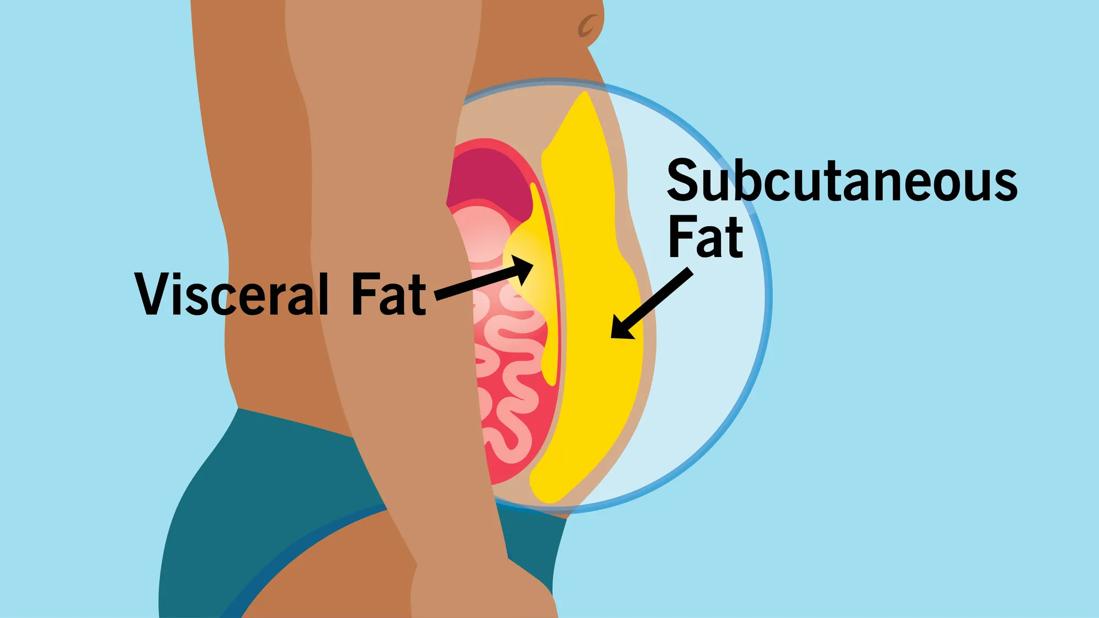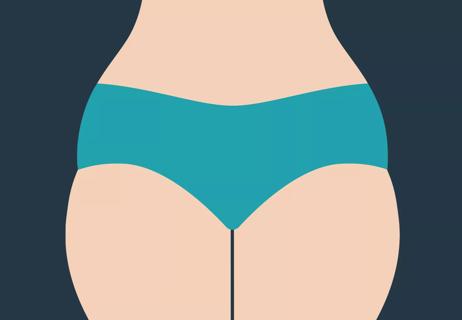Visceral fat surrounds your organs and can be more detrimental to your health

We all have fat tissue on our bodies.
Advertisement
Cleveland Clinic is a non-profit academic medical center. Advertising on our site helps support our mission. We do not endorse non-Cleveland Clinic products or services. Policy
Yes, everyone.
Even the finely tuned athletes gracing the covers of bodybuilder magazines have some.
It’s normal, and our bodies need a certain amount of fat to keep things moving. Fat isn’t inherently “bad.” It’s a vital part of how our bodies work.
“Fat is stored energy,” says family medicine physician David Brill, DO. “Your body saves up extra calories so it can use them when it needs more energy. For almost all of human history, starvation was a much bigger threat than obesity. So, our bodies evolved to store excess energy for when food is scarce.”
But how much you have and where it’s stored can make a big difference when it comes to your health. That’s why understanding the differences between visceral fat and subcutaneous fat matters.
Your body stores excess calories as one of two kinds of fat:
Here’s a quick chart to see the difference:
| Visceral fat | Subcutaneous fat | |
|---|---|---|
| Location | Deep in your belly | Just under your skin, all around your body |
| Appearance | Hard | Soft and squishy |
| Examples | "Beer belly" or "apple shape" | “Love handles” and “muffin tops” |
| Health risks | High blood pressure, high cholesterol, high blood sugar | Increased risk of visceral fat |
| Location | ||
| Visceral fat | ||
| Deep in your belly | ||
| Subcutaneous fat | ||
| Just under your skin, all around your body | ||
| Appearance | ||
| Visceral fat | ||
| Hard | ||
| Subcutaneous fat | ||
| Soft and squishy | ||
| Examples | ||
| Visceral fat | ||
| "Beer belly" or "apple shape" | ||
| Subcutaneous fat | ||
| “Love handles” and “muffin tops” | ||
| Health risks | ||
| Visceral fat | ||
| High blood pressure, high cholesterol, high blood sugar | ||
| Subcutaneous fat | ||
| Increased risk of visceral fat |
Troubles can arise when you have more fat in storage than your body needs. Visceral fat is the one to be most wary of.
Advertisement
It’s not about your appearance either — it’s about your risk for serious health concerns.
Visceral fat takes up space inside your abdomen. That means it gets in the way of vital organs, like your liver, kidneys and intestines. It puts extra pressure on them and keeps them from doing their jobs efficiently.
“Visceral fat contributes to what I call ‘the three horsemen of the apocalypse’: high blood pressure, high cholesterol and high blood sugar,” Dr. Brill shares. “Those are the beginning points for things like diabetes, heart disease, kidney disease, stroke and other life-threatening health conditions.”
Subcutaneous fat, on the other hand, isn’t as problematic on its own. But having excess subcutaneous fat is often a sign of more visceral fat, so it’s not without its risks.
Our bodies are very good at making the most of what they get. When we eat and drink calories, our cells use only what they need and hold on to the rest.
It’s a kind of biological savings account: When your body needs more energy, it’ll pull from those reserves to power your systems. But when and why it’s stored as visceral or subcutaneous fat isn’t cut and dried. A lot of it has to do with your genetics.
“If you look at families, you can see a lot of similarities in how their body weight is distributed,” Dr. Brill points out. “If your biological parents and grandparents were prone to visceral fat, chances are, you will be, too.”
Unfortunately, there’s no easy way to target losing one kind of fat over the other. Your lifestyle and your genetics will determine where it accumulates and where your body turns to use up its stores first.
That said, losing excess body fat can help your body work its best. Burning subcutaneous fat will lower your risk of visceral fat, which, in turn, will lower your risk for serious chronic conditions.
But how? “The only way to burn off fat is to live off of it,” Dr. Brill states.
That means you need to create a calorie deficit — burn more energy than you take in.
Try:
Aim for at least 150 minutes of moderate-intensity aerobic exercise each week, and add more as you become accustomed to it.
And don’t neglect the strength-training exercises two or three days a week. Without adequate attention, your body can start pulling energy from your muscle stores, rather than visceral or subcutaneous fat. That’s not doing your health any favors. Muscle is important for going about your daily activities, and it helps burn more fat, too.
At the end of the day, you need fat to live. It’s there to keep your body moving in times of scarcity. But too much can hurt your health. If that’s you, talk with a healthcare provider about how your body composition is affecting your well-being and what to do about it.
Advertisement
Advertisement
Learn more about our editorial process.
Advertisement

Some treatments may temporarily reduce the appearance of puckered and dimpled skin

Fat exits your body in your breath, pee and sweat

Weight gain is natural as we age — but it can be cause for concern

Seeing double (chins) when taking selfies? From exercises to surgery, you can reduce or eliminate chin fat, but there’s no overnight solution

Discover why one kind of fat can be fatal

The short answer from a medical weight management expert

It’s commonly mistaken for obesity

It helps to take a long-range view

Start having sex about 72 hours before ovulation, then at least every other day during your fertile window

Attachment theory suggests that your earliest relationships shape connections throughout your life

It isn’t a recognized mental health disorder, but research shows that problematic social media use can negatively affect your mental health, self-esteem and sleep